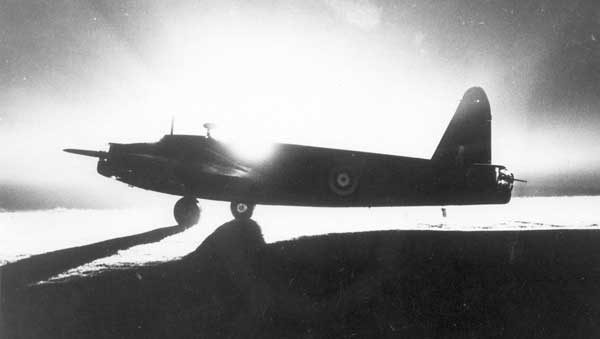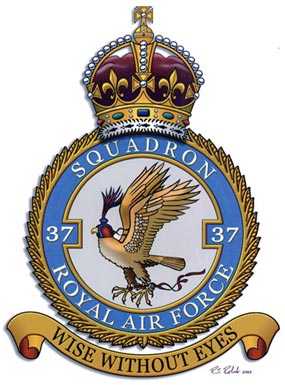OP 37 - UDINE/CAMPOFORMIDO AERODROME
November 17, 1944 (night): 39 aircraft of 205 Group including 10 Wellingtons of 37 Squadron were detailed to attack the airfield at Udine/Campformido on this night. This aerodrome was being used to intercept American heavy bombers operating on daylight missions in this area. The object of the attack was to crater the runways, destroy buildings on the airfield, and render it unserviceable.

A No. 37 Squadron Wellington taxis for
takeoff.
W/O MacIsaac and crew took off from Tortorella at 1800 hours in Wellington Mk.X LP572 "D" carrying nine 500 pound bombs. ETA at the aerodrome was approximately two and one half hours.
The weather was good. There were patchy clouds near base at 5000 feet and high cloud at 10,000 feet - hazy visibility conditions overall but this cleared as the Squadron neared the target area.
En route to the target the first of a series of unexplained lights was seen. Over Ancona the colors of the day (the colors of ground signals & flares were changed daily) were seen fired many times and a beacon was observed flashing "0-1" repeatedly. At 1951 hours, some 90 miles north of Ancona, directly on track with the bomber stream, a reddish fire was seen "burning in the sea" for about five minutes.
Arriving over the target area the crews were met by accurate, heavy caliber flak. Illumination flares were dropped on time and were well placed enabling all crews to identify the target. Red TI’s were dropped at 2057 hours south of the aerodrome and at 2059 hours on the center of the aerodrome at the south-west end of the runway. Bombing took place between 2957 and 2106 hours from heights of 7000 to 9000 feet.
Nine aircraft bombed on the red TI’s with two observing bursts on the runway. Wellington "J", captained by F/L Ralph, scored a direct hit on Administration buildings in the east end of the north section of the aerodrome with a 4000 pound "cookie". One Wellington bombed visually before the TI’s were dropped and observed bursts across the landing strip. Two crews, including MacIsaacs, reported fires among hangars at the east end of the south section of the aerodrome.
On the return trip crews observed what appeared to be a red and green signal light in the sky, followed by a red flare which descended to the ground, breaking up into a number of fires with a large mass at the center.
Two aircraft of 205 Group and their crews were lost on this operation. How they were lost was never discovered. The unexplained lights and fires led to the conclusion that the aircraft were "possibly lost to enemy intruder fighters" but the exact cause remains a mystery.
MacIsaac landed safely at Tortorella at 2310 hours.
<< PREVIOUS |
NEXT >>
Home | Table of Contents

